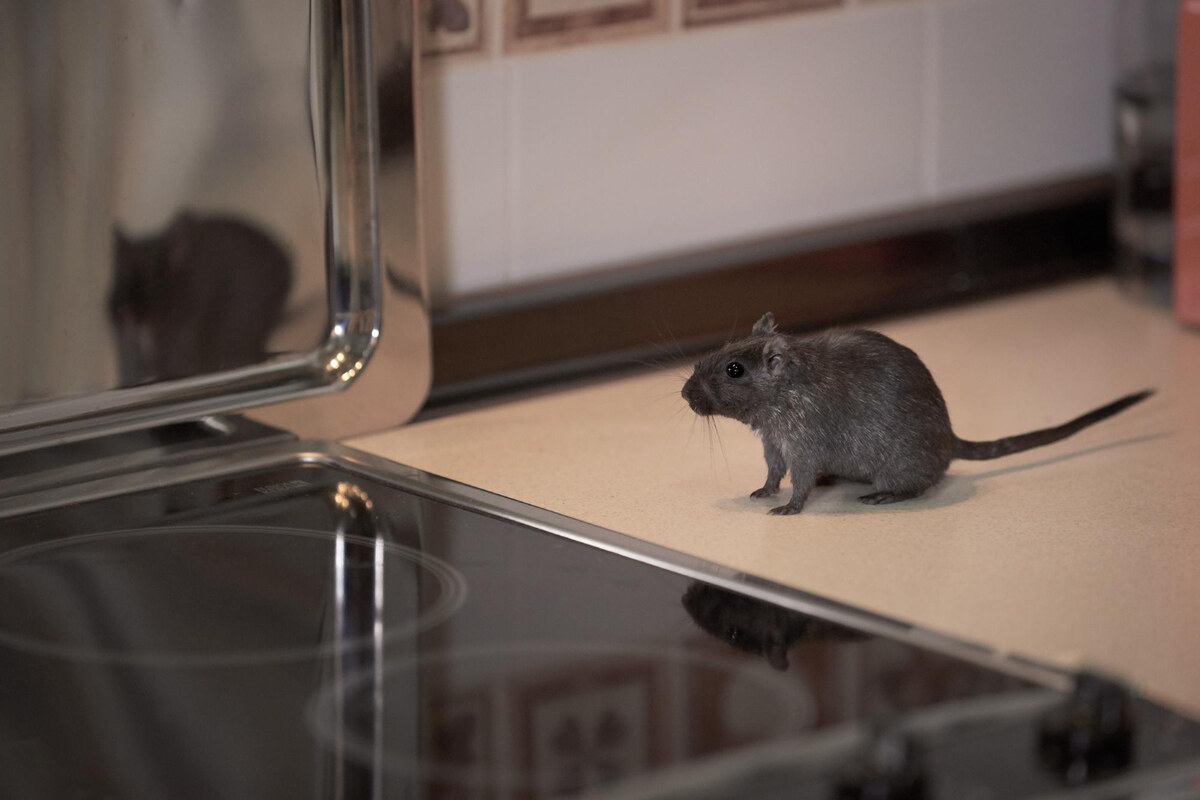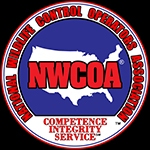The restaurant business is as much about cleanliness as it is about service. The silent menace of rodent infestation can easily ruin the smell of freshly prepared food and the comfort of excellent service. These unwanted visitors are capable of not only ruining your reputation but also causing severe health violations and closures.
Rodents leave a trail of evidence, starting with a single mouse in the pantry to indications of nests behind the fridge. The difficulty is to identify the issue early and act accordingly, before it becomes a full-blown crisis.
This guide will assist you in identifying the initial signs of rodent infestation in restaurants and how you can act quickly and intelligently to safeguard your customers, employees, and business.
What Is Rodent Infestation?
Rodent infestation is a situation whereby mice, rats, or other rodent species breed in a building, particularly where food and warmth are easily accessible. In the case of restaurants, the risk is increased because food is being prepared, wasted, and foot traffic is constant, which is an ideal rodent habitat.
But what is rodent infestation other than seeing a rat? It is a chain reaction of droppings in the kitchen, chewed wires close to the freezer, and contaminated food storage that can influence operations and cause severe health risks.
Usually, an infestation does not start with dozens of rodents. It begins with one or two that discover a good source of food. This may turn into a colony in a matter of weeks unless it is dealt with promptly. This is why the initial signs of infestation should not be overlooked. When you see one mouse, chances are that there are more hiding around.
Moreover, rodents may be carriers of dangerous pathogens. Rodent infestation health risks include the transmission of Salmonella, E. coli, and even Hantavirus. The diseases may be spread by droppings, urine, or even air particles. This is a disaster in foodservice settings.
Common Signs of Rodent Infestation in Restaurants
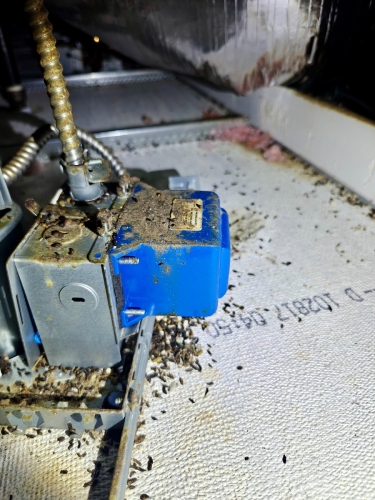
Rodents are clever, but they never leave without a trace. Being aware of what to consider can make your employees respond promptly and responsibly.
Rodent Droppings and Urine Trails
Droppings are one of the most noticeable rodent infestation indicators, small dark pellets that are commonly located in food prep areas, baseboards, or storage areas. New droppings are soft and wet, whereas old ones become dry and crumbly.
Along with these come urine trails, which can be seen or not seen, but can be detected under UV light. When you smell a strong ammonia-like smell, it is usually the result of built-up rodent urine, which is a sure sign that you have an active rodent problem.
Gnaw Marks on Packaging and Equipment
Rodents chew all the time to keep their teeth trimmed. You may see bite marks on food containers, cardboard boxes, wooden shelves, or even plastic utensils. Others even bite on electric wires, raising the chances of fire.
These gnaw marks are often the first sign of rodent infestation before the actual pests are seen. If the damage is new and extensive, it may indicate a population increase and the necessity to eliminate the infestation as soon as possible.
Nests Made from Shredded Materials
A nest is probably found when you discover a pile of shredded paper, cloth, or insulation hidden behind appliances or in corners of storage areas. Rodents nest in warm, concealed places near food. Nesting material may consist of napkins, insulation, cardboard, and even plastic wrap.
Grease Smudges and Rub Marks
Rodents leave streaks and dark smudges on walls, pipes, and baseboards as their oily fur rubs against them while they move through the tight spaces. With continued travel, visible runways are formed. Such paths may lead pest professionals to areas of high activity.
The presence of these marks is a warning sign. Not only does it verify the presence of rodents, but it also assists in identifying entry points and frequently used routes, which are fundamental in effective rodent control.
Scratching and Movement Sounds
When restaurants close down, they become quiet, but when you hear scratching behind the walls, above the ceilings, or around the storage units, it is probably rodents. They are usually referred to as scuttling or gnawing noises and are usually heard at night when rodents are most active.
These noises are usually ignored, yet they are important symptoms of rodent infestation in restaurants, particularly when they are accompanied by other symptoms such as droppings or chewed objects.
Rodent Infestation Signs in Different Areas of a Restaurant
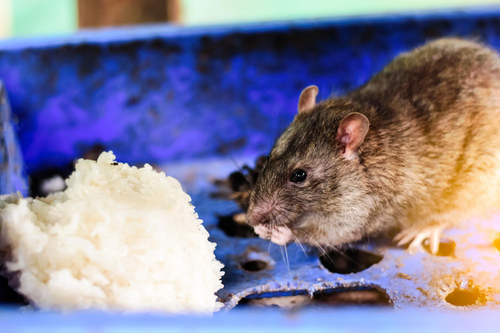
Rodents are non-discriminatory; they will go where food, warmth, and shelter are available. This is why it is important to be alert in all areas of your restaurant.
Kitchen and Food Preparation Areas
This is the most risky area for contamination. Check behind equipment, under sinks, or in cupboards. A single sighting must prompt an immediate reaction, such as sanitation, inspection, and possibly scheduling a rodent infestation cleanup.
Kitchens are the most appealing area to rodents due to food particles, grease accumulation, and moisture. Without control, infestations in this area may cause significant health code violations.
Pantry and Storage Rooms
Rodents prefer dark and silent places where food is kept. Rice, flour, and dry goods can be chewed through in bags. Nests may also be found in corners or shredded packaging left behind.
A quick inspection for rodent infestation signs should be done every time one visits the storage areas.
Dumpsters and Garbage Disposal
Rodents are attracted to outside bins and indoor waste stations. These are perfect breeding grounds because of leaky trash bags, unsealed containers, and infrequent cleaning. When rodents consider your dumpsters to be welcoming, they will ultimately get in.
The setting of stringent garbage measures helps control infestation and prevent recurring issues. Rodent-proof trash bins and clean dumpsters are minor improvements with major payoffs.
Restaurants and Customer Zones
Although it is not common, the presence of rodents in the dining room can destroy the reputation of your restaurant overnight. Feces beneath booths, grease stains in plain view of vents, or even a single mouse on the floor during service can result in social media outrage and health department fines. “A single negative Google result can cut revenue by 22%” (SurveySparrow’s).
Knowing how to deal with rodent infestation at this stage often requires full professional involvement.
How Professional Rodent Infestation Removal Protects Your Restaurant
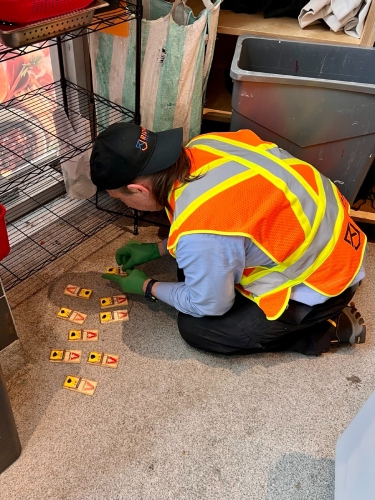
Once the indicators of a rodent infestation start to appear, simply placing a couple of traps and hoping that they will work is not sufficient. The expertise and thoroughness of professional intervention are something that DIY methods can never hope to achieve, particularly in a high-stakes setting such as a restaurant.
This is how a trained team can make a difference:
- Effective and Thorough Rodent Infestation Removal: Professionals do not simply remove what is seen. They examine walls, ceilings, drains, and other hidden areas to reveal the extent of the problem. Professional teams can detect and seal entry points, and this will ensure long-term success rather than short-term solutions.
- Compliance with Health and Safety Regulations: Health inspectors do not tolerate half-measures. A professional service will make your business comply with municipal and provincial standards. This reduces the chances of closures and fines from rodent infestation health risks.
- Tailored Solutions for Restaurants: Restaurants require non-obstructive service. Trusted companies such as Ridall Pest Control provide flexible scheduling and specific treatment plans to eradicate infestations without affecting service hours or guests.
- Preventative Monitoring and Ongoing Support: The best strategy isn’t just knowing how to deal with rodent infestation, but also how to prevent one. Future risks are kept at bay through regular inspections, bait stations, and staff training.
- Specialized Pest Control for Mice: Mice do not act like rats and therefore need special methods of elimination. Professionals know the difference and use the right tools to deal with both.
Restaurants that collaborate with such services as Ridall Pest Control enjoy not only reactive treatment but also proactive defence. And in the food industry, it is all about being ahead of the problem.
Conclusion – Safeguarding Your Restaurant from Rodents
One mouse sighting may not seem like a crisis, but in the restaurant business, it can escalate rapidly. The indicators of rodent infestation in restaurants are usually not obvious initially, such as grease marks, droppings, or slight scratching on the walls. However, the neglect of even the slightest sign may have severe consequences.
Your business can be ahead of the problem by learning to identify all the signs of rodent infestation, where rodents hide, and how to control rodent infestation with the help of professionals.
If you’re in Vancouver or the Lower Mainland and need expert help, Ridall Pest Control is your reliable ally in keeping a clean, compliant, and rodent-free facility. With over 30 years of experience, we offer efficient solutions that are specifically designed to fit your business.
Waiting until a health inspection to tell you what you already suspect is not the best idea. Contact us today and stay protected. Let Ridall Pest Control help you put an end to rodents for good.

